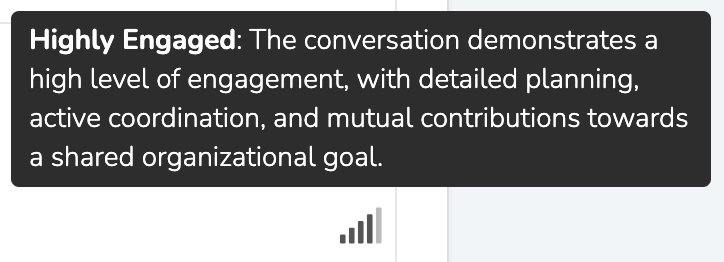Call AI
The Professional plan offers Call AI functionality, which currently consists of Call Transcriptions and Call Summaries. To enable this functionality, go to Settings -> Call AI, and toggle the "Call Transcriptions" field.
Privacy and Compliance: It's important to note that calls are transcribed and summarized without being permanently recorded. However, we advise all users to familiarize themselves with and adhere to state-specific call recording laws to ensure compliance. Informing participants that the call may be transcribed is a best practice that can help maintain transparency and trust.
AI Features
Call Summaries & Transcriptions
Our platform enhances your communication insights by providing automatic transcriptions and summaries for all outgoing calls exceeding 90 seconds in duration. This feature is designed to empower your team with a detailed account of each call, facilitating better follow-ups, training, and analysis.
Transcriptions
Every word spoken during the call is transcribed verbatim, giving you a complete textual representation of the conversation. This transcription is invaluable for detailed review, training purposes, or when you need to reference specific details discussed during the call.
Summaries
In addition to transcriptions, calls are distilled into concise summaries. These summaries capture key points, decisions made, and action items, offering a quick way to grasp the essence of the conversation without reading through the entire transcript.
Accessibility:
Both the transcription and summary are seamlessly integrated into the called contact's Activity Timeline. This centralized access ensures that team members can quickly find and review call details as needed, directly within the contact's profile. Calls that happen in languages other than English, will be summarized in English.
Talk/Listen Ratios

This feature provides insights into the dynamics of your team's communication by displaying the percentage of time each member spends talking versus listening during a call. Understanding these metrics can help improve conversational balance and ensure effective team collaboration.
Engagement Analysis

Our Call Engagement Analysis feature measures how involved people are in a phone call. It checks how deep and balanced the conversation is, if the talk is meaningful, and if people seem committed to working together. The tool shows engagement with up to five bars — more bars mean a higher level of engagement. You can hover over the bars to see why a particular call got its rating.
Overview of Call Recording Laws
This document offers a summary of call recording laws, emphasizing the importance of understanding and complying with various consent requirements.
Disclaimer: This document is intended for informational purposes only and should not be considered a comprehensive guide to call recording laws or a substitute for legal advice. It offers a general understanding of the subject to aid in your awareness of call recording laws. As legal advice must be tailored to the specific circumstances of each case, and laws are constantly changing, we strongly encourage consulting with a legal professional for personalized advice and to confirm the accuracy of this information.
United States Call Recording Laws
Differences Between One-Party, Two-Party, and Mixed Consent Laws
-
One-Party Consent: Only one person involved in the conversation needs to consent to the recording.
-
Two-Party Consent: All parties involved in the conversation must consent to the recording.
-
Mixed Consent: These laws vary depending on the situation. They can require one-party consent in some contexts and two-party consent in others, often influenced by factors such as the type of communication (electronic, in-person) and the participant's role in the conversation.
One-Party Consent States
In these states, only one party needs to consent to the recording of a conversation:
Alabama, Alaska, Arizona, Arkansas, District of Columbia, Georgia, Hawaii, Idaho, Indiana, Iowa, Kansas, Kentucky, Louisiana, Maine, Michigan, Minnesota, Mississippi, Missouri, Nebraska, New Jersey, New Mexico, New York, North Carolina, North Dakota, Ohio, Oklahoma, Rhode Island, South Carolina, South Dakota, Tennessee, Texas, Utah, Vermont, Virginia, West Virginia, Wisconsin.
Two-Party Consent States
All parties must consent to the recording in these states:
California, Delaware, Florida, Illinois, Maryland, Massachusetts, Montana, New Hampshire, Pennsylvania, Washington.
Mixed Consent States
These states have specific conditions or mixed requirements based on the situation:
- Colorado: One-party consent for electronic or oral communication, but all parties must consent if the individual recording is not involved in the conversation.
- Connecticut: All-party consent is required for phone calls (with written consent, verbal notification at the start, and regular beep tones during the call), but one-party consent suffices for in-person conversations.
- Nevada: Despite being a one-party consent state by law, the Nevada Supreme Court requires all-party consent for telephonic communication.
- Oregon: One-party consent for electronic communication, but all parties must consent for in-person communication.
Updated 9 days ago
